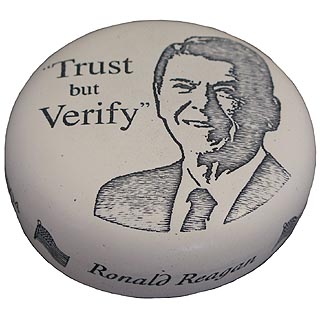With Innovation, It’s Trust But Verify.
 Your best engineer walks into your office and says, “I have this idea for a new technology that could revolutionize our industry and create new markets, markets three times the size of our existing ones.” What do you do? What if, instead, it’s a lower caliber engineer that walks into your office and says those same words? Would you do anything differently? I argue you would, even though you had not heard the details in either instance. I think you’d take your best engineer at her word and let her run with it. And, I think you’d put less stock in your lesser engineer, and throw some roadblocks in the way, even though he used the same words. Why? Trust.
Your best engineer walks into your office and says, “I have this idea for a new technology that could revolutionize our industry and create new markets, markets three times the size of our existing ones.” What do you do? What if, instead, it’s a lower caliber engineer that walks into your office and says those same words? Would you do anything differently? I argue you would, even though you had not heard the details in either instance. I think you’d take your best engineer at her word and let her run with it. And, I think you’d put less stock in your lesser engineer, and throw some roadblocks in the way, even though he used the same words. Why? Trust.
Innovation is largely a trust-based sport. We roll the dice on folks that have already put it on the table, and, conversely, we raise the bar on those that have not yet delivered – they have not yet earned our trust. Seems rational and reasonable – trust those who have earned it. But how did they earn your trust the first time, before they delivered? Trust.
There is no place for trust in the sport of innovation. It’s unhealthy. Ronald Reagan had it right:
Trust, but verify.
As we know, he really meant there was no place for trust in his kind of sport. Every action, every statement had to be verified. The consequences so cataclysmic, no risk could be tolerated. With innovation consequences are not as severe, but they are still substantial. A three year, multi-million (billion?) dollar innovation project that returns nothing is substantial. Why do we tolerate the risk that comes with our trust-based approach? I think it’s because we don’t think there’s a better way. But there is. What we need is some good, old-fashioned verification mixed in with our innovation.
When the engineer comes into your office and says she can reinvent your industry, what do you ask yourself? What do you want to verify? You want to know if the new idea is worth a damn, if it will work, if there are fundamental constraints in the way. But, unfortunately for you, verification requires knowledge of the physics, and you’re no physicist. However, don’t lose hope. There are two simple tactics, non-technical tactics, to help with this verification business.
First – ask the engineers a simple question, “What conflict is eliminated with the new technology?” Good, innovative technologies eliminate fundamental, long standing conflicts. These long standing conflicts limit a technology in a way that is so fundamental engineers don’t even know they exist. When a fundamental conflict is eliminated, long held “design tradeoffs” no longer apply, and optimizing is replaced by maximizing. With optimizing, one aspect of the design is improved at the expense of another. With maximizing, both aspects of the design are improved without compromise. If the engineers cannot tell you about the conflict they’ve eliminated, your trust has not been sufficiently verified. Ask them to come back when they can answer your question.
Second – when they come back with their answer, it will be too complex to be understood, even by them. Tell them to come back when they can describe the conflict on a single page using a simple block diagram, where the blocks, labeled with everyday nouns, represent parts of the design intimately involved with the conflict, and the lines, labeled with everyday verbs, represent actions intimately involved with the conflict. If they can create a block diagram of the conflict, and it makes sense to you, your trust has been sufficiently verified. (For a post with a more detailed description of the block diagrams, click on “one page thinking” in the Category list.)
Though your engineers won’t like it at first, your two-pronged verification tactics will help them raise their game, which, in turn, will improve the risk/reward ratio of your innovation work.
 Mike Shipulski
Mike Shipulski